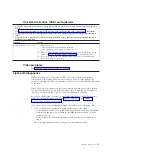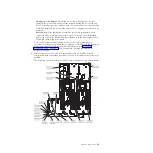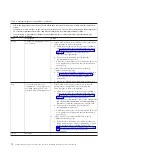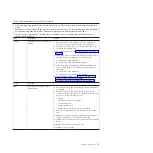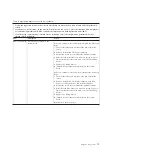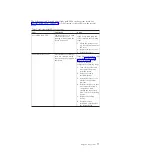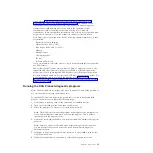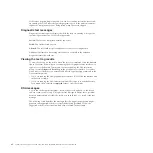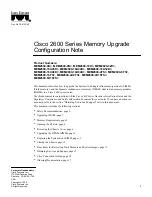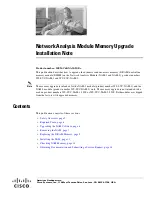
Table 6. Light path diagnostics panel LEDs (continued)
v
Follow the suggested actions in the order in which they are listed in the Action column until the problem is
solved.
v
See Chapter 3, "Parts listing", in the
Problem Determination and Service Guide
to determine which components
are customer replaceable units (CRU) and which components are field replaceable units (FRU).
v
If a action step is preceded by "(Trained service technician only)," that step must be performed only by a
trained service technician.
LED
Description
Action
PCI
An error has occurred on a PCI
bus or on the system board. An
additional LED is lit on one of
the riser cards.
1.
Check the system-event log for information about the
error.
2.
Check the LEDs on the PCI riser cards to identify the
component that caused the error.
3.
If you cannot isolate the failing adapter by using the
LEDs and the information in the system-event log,
remove one adapter at a time from the failing PCI bus;
and restart the server after each adapter is removed.
4.
Replace the following components, in the order shown,
restarting the server each time:
v
PCI riser card
v
(Trained service technician only) Replace the system
board.
SP
A service processor error has
been detected.
1.
Remove power from the server; then, reconnect the server
to power and restart the server.
2.
Update the IMM firmware (see “Updating the firmware”
on page 397).
3.
(Trained service technician only) Replace the system
board, if the problem remains.
FAN
A fan has failed, is operating too
slowly, or has been removed. The
TEMP LED might also be lit.
1.
Check the LEDs on the server and the front of the MAX5
(if installed).
2.
Reseat the failing fan, which is indicated by a lit LED on
the fan.
3.
Replace the failing fan.
TEMP
The system temperature has
exceeded a threshold level. A
failing fan can cause the TEMP
LED to be lit.
1.
Make sure that the air vents are not blocked.
2.
Determine whether a fan has failed. If it has, replace it.
3.
Make sure that the heat sink is seated correctly.
4.
Make sure that the room temperature is not too high. See
“Server features and specifications” on page 8 and
“System reliability guidelines” on page 262 for the server
temperature information.
MEM
Memory failure.
Check the event logs, see “Event logs” on page 35 for
applicable memory events; then, follow the steps as indicated
in the POST error codes (see “POST error codes” on page 38)
or IMM error messages (see “Integrated management module
(IMM) error messages” on page 168).
NMI
A nonmaskable interrupt has
occurred.
Check the system-event log for information about the error.
Chapter 3. Diagnostics
71
Summary of Contents for System x3690 X5
Page 1: ...System x3690 X5 Types 7147 7148 7149 and 7192 Problem Determination and Service Guide...
Page 2: ......
Page 3: ...System x3690 X5 Types 7147 7148 7149 and 7192 Problem Determination and Service Guide...
Page 8: ...vi System x3690 X5 Types 7147 7148 7149 and 7192 Problem Determination and Service Guide...
Page 13: ...Safety statements Safety xi...
Page 22: ...4 System x3690 X5 Types 7147 7148 7149 and 7192 Problem Determination and Service Guide...
Page 266: ...248 System x3690 X5 Types 7147 7148 7149 and 7192 Problem Determination and Service Guide...
Page 278: ...260 System x3690 X5 Types 7147 7148 7149 and 7192 Problem Determination and Service Guide...
Page 386: ...368 System x3690 X5 Types 7147 7148 7149 and 7192 Problem Determination and Service Guide...
Page 407: ...1 2 Chapter 5 Removing and replacing components 389...
Page 444: ...426 System x3690 X5 Types 7147 7148 7149 and 7192 Problem Determination and Service Guide...
Page 454: ...436 System x3690 X5 Types 7147 7148 7149 and 7192 Problem Determination and Service Guide...
Page 461: ...weight of memory enclosure 28 Index 443...
Page 462: ...444 System x3690 X5 Types 7147 7148 7149 and 7192 Problem Determination and Service Guide...
Page 463: ......
Page 464: ...Part Number 47C8865 Printed in USA 1P P N 47C8865...











